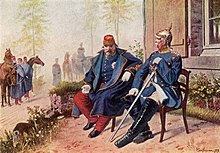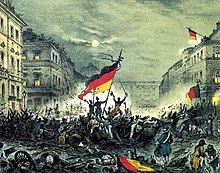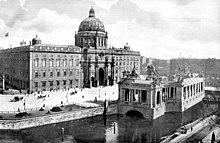German Empire
German Empire is the retrospective term for the phase of the German Empire from 1871 to 1918 to clearly distinguish it from the period after 1918. In the German Empire, the German nation-state was a constitutional monarchy organized as a federal state (or constituent state).
The founding of the German Empire took place at the beginning of the effectiveness of the new constitution on January 1, 1871. It was staged by a less than spectacular, secretly prepared military-courtly ceremony, the imperial proclamation of the Prussian King Wilhelm I on January 18, 1871 in the Hall of Mirrors at Versailles. Meanwhile, the empire was still engaged in the Franco-Prussian War. On a small German basis and under the rule of the Prussian Hohenzollerns, a German nation state had thus come into being for the first time. The main residence of the German emperor and Prussian king was the Berlin Palace.
During the period of the German Empire, Germany's economic and social history was characterized by high industrialization. Economically and socio-structurally, it began to change from an agricultural to an industrial country, especially from the last decades of the 19th century. The service sector also gained in importance with the expansion of trade and banking. The economic growth, which was also caused by the French war reparations after 1871, was temporarily slowed by the so-called Gründerkrach of 1873 and the long economic crisis that followed it. Despite considerable political consequences, this did not change the structural development toward an industrial state.
The social transformation was characterized by a strongly internationally oriented reform movement, in the course of which the "social question" was advanced with scandalizing and combating poverty, but democratic reforms and women's rights were also pushed. The structural basis of these changes, in addition to mass politicization, was rapid population growth, internal migration and urbanization. The structure of society was substantially altered by the growth of the urban working-class population and - especially in the years from about 1890 onward - also of the new middle class, consisting of technicians, white-collar workers and small and medium-sized civil servants. By contrast, the economic importance of crafts and agriculture - in terms of their contributions to national income - tended to decline.
Until 1890, domestic and foreign policy developments were determined by the first and longest-serving chancellor of the empire, Otto von Bismarck. His reign can be divided into a relatively liberal phase, characterized by domestic reforms and the Kulturkampf, and a more conservative period after 1878/79. The transition to state interventionism (protective tariffs, social insurance) and the Socialist Act are considered to be a caesura.
In foreign policy, Bismarck attempted to secure the empire through a complex system of alliances (e.g., the Dual Alliance with Austria-Hungary in 1879). From 1884 onward, Bismarck began to engage in overseas imperialism, a process that was later intensified. This was followed by international conflicts of interest with other colonial powers, especially the world power Great Britain.
The phase following the Bismarck era is often referred to as the Wilhelmine Age because Kaiser Wilhelm II (from 1888) personally exerted considerable influence on day-to-day politics after Bismarck was dismissed. However, other actors, some of them competing, also played an important role. They influenced the emperor's decisions and often made them appear contradictory and unpredictable.
Moreover, the rise of mass associations and parties and the growing importance of the press increased the weight of public opinion. Not least for this reason, the government attempted to increase its popular support with an imperialist world policy, an anti-social democratic rallying policy, and a popular armament of the fleet (see Fleet Laws). In foreign policy, however, Wilhelm's pursuit of world power led to isolation; through this policy, the empire helped increase the risk of the outbreak of a major war. When this First World War was finally triggered in 1914, the Reich was involved in a multi-front war. The military also gained influence in domestic politics. With the increasing number of war dead on the fronts and social hardship at home (fostered by Allied naval blockades), the monarchy began to lose support.
It was not until the end of the war that the October reforms of 1918 took place, which stipulated, among other things, that the Reich Chancellor had to have the confidence of the Reichstag. Soon thereafter, the Republic was proclaimed in the November Revolution, and the constituent National Assembly in Weimar constituted the Reich as a parliamentary democracy in 1919. Under international law, today's Germany is identical to the German Reich of 1871, although the form of government and administrative territory have changed several times since then.
Previous story
Until the founding of the nation-state, German history in the 19th century was characterized by multiple political and territorial changes, which had entered a new phase after the end of the Holy Roman Empire of the German Nation from 1806. The Old Reich, a pre- and supranational entity led by the Roman-German emperors - since the middle of the 18th century increasingly characterized by the clashing interests of its two great powers, Austria and the rising Prussia - broke up as a result of the Napoleonic Wars and the founding of the Confederation of the Rhine initiated by France.
The ideas of the French Revolution between 1789 and 1799 and the wars of liberation directed against Napoleon Bonaparte's subsequent hegemonic policy led to nation-state movements in almost all of Europe, including the German-speaking area, with the idea of the nation as the basis for state formation. The Greater German solution was a unified empire including the German settlement areas of the empire of Austria, Prussia and Denmark; the Small German solution was a German empire correspondingly without Austria under Prussian leadership.
However, after the victory of the European powers opposed to France (led by Great Britain, Prussia, Russia and Austria) over Napoleon's armies, the German princes had no interest in a central power that would limit their own rule. Therefore, at the Congress of Vienna in 1815, only the German Confederation was founded, a loose union of those territories that had belonged to the Holy Roman Empire of the German Nation before 1806. The era that followed the Congress of Vienna, referred to in later historiography as the Vormärz, was characterized by the politics of restoration, dominated supranationally by the Austrian state chancellor Clemens Wenzel Prince von Metternich. Within the framework of the so-called Holy Alliance, an alliance initially formed between Austria, Prussia, and Russia, the Restoration was intended to restore, both domestically and intergovernmentally, the balance of power in Europe that had prevailed under the Ancien Régime until the French Revolution.
Nation-state and bourgeois-democratic movements opposed restorationist policies. In the revolutionary year of 1848 in large parts of Central Europe, the March Revolution in the German states also became involved in the revolutionary movement. After the adoption of the Paulskirche constitution, members of the first all-German, democratically elected parliament, the Frankfurt National Assembly, offered the German imperial crown to the Prussian King Frederick William IV as part of the all-German solution. But because the latter refused, citing his "divine right," the attempt to unify the majority of the German states on a constitutional basis failed.
After the ultimately violent suppression of the revolutionary movement of 1848/49, the German Confederation continued to exist until 1866. After a decade of political reaction (reaction era), in which democratic and liberal aspirations were once again suppressed, the first political parties in the modern sense were formed in the German states from the early 1860s. The relationship between Austria and Prussia was characterized by cooperation in the 1850s, then by rivalry again. Different ideas became apparent, for example, at the Frankfurt Fürstentag in 1863: Austria and the central states such as Bavaria wanted to expand the German Confederation as a confederation of states, while Prussia preferred a federal solution. In the German-Danish War of 1864, the two great powers cooperated again, but then fell out over the spoils of Schleswig-Holstein.
Prussian provocation (the invasion of Austrian-administered Holstein) triggered the German War of Prussia against Austria in 1866, in which the armies of Prussia and some northern German states fought together with Italy against the troops of Austria, which was allied with the southern German states, including Baden, Bavaria, Hesse and Württemberg. After the defeat, Austria had to recognize the dissolution of the German Confederation and accept that Prussia founded the North German Confederation with the states north of the Main line as an initially military alliance. This was given a federal constitution in 1867. The southern German states, which had previously been allied with Austria, concluded protection and defense alliances with Prussia.
Triggered by a diplomatic dispute over the Spanish succession, the Franco-PrussianWar began in 1870. The declaration of war came from the French side after Prussian Prime Minister Bismarck had politically exposed France. The southern German states participated in the war and joined the North German Confederation on January 1, 1871. The three wars between 1864 and 1871 are also known as the Wars of German Unification.

Otto von Bismarck and French Emperor Napoleon III after the Battle of Sedan (after a painting by Wilhelm Camphausen from 1878)

Cheering revolutionaries after barricade fights on March 18, 1848 in Berlin (chalk lithograph by an unknown artist)
Reichsgründung
→ Main article: Founding of the German Empire
The German victory at Sedan and the capture of the French Emperor Napoleon III. (both on September 2, 1870) cleared the way for the founding of the Reich. Bismarck began negotiating with the southern German states. This meant the accession of Bavaria, Württemberg and Baden to the North German Confederation through the establishment of a new "German Confederation" agreed in November 1870. Other plans, such as that of a double confederation as proposed by Bavaria, now stood no chance. The Bismarckian solution guaranteed Prussia's dominance in the new, so-called second German Reich. On the other hand, the strengthened monarchical federalism meant a barrier against tendencies toward parliamentarization.
Demands for annexation of Alsace and parts of Lorraine were raised among the German public, and Bismarck made these demands his own. This prolonged the war, was a reason for strengthening the "Franco-German hereditary enmity" (see also French revanchism), and gave further impetus to national enthusiasm in Germany. The latter facilitated Bismarck's negotiations with the southern German states, which resulted in the November treaties.
Nevertheless, he had to make concessions, the so-called reserve rights. In peacetime, Bavaria retained its own army (Bavarian Army). Moreover, like Württemberg, it retained its own postal system. The southern German states as a whole retained their state railroads (Royal Bavarian State Railways, Royal Württemberg State Railways, Grand Ducal Baden State Railways, Grand Ducal Hesse State Railways). In foreign policy, they successfully insisted on their own diplomatic relations.
The Prussian king, holder of the Federal Presidency, was given the additional title of "German Emperor". This designation was of secondary importance in terms of state law, but of considerable symbolic significance - the memory of the Old Reich facilitated identification with the new state. In order to emphasize the monarchical legitimacy of the nation-state, it was important to Bismarck that King Ludwig II, as the monarch of the largest accession country, should offer the imperial crown to King Wilhelm I. The new state was also to be named German Emperor. After making arrangements to supplement his private coffers, the reluctant but politically isolated Bavarian king agreed to this step and proposed King Wilhelm as German emperor in the imperial letter of November 30, 1870, prewritten by Bismarck. The secret annual allocations that Bismarck diverted from the Guelph Fund for Ludwig totaled 4 to 5 million marks. Characteristic of the character of the new empire was that the representatives of the North German Reichstag had to wait until the federal princes had declared their consent to the imperial dignity. Only then were the deputies allowed to ask the king to accept the imperial crown. This was in marked contrast to the imperial deputation of 1849.
King Wilhelm himself, who feared - not without reason - that the new title would obscure the Prussian royal dignity, remained dismissive for a long time. If anything, he demanded the title of "Emperor of Germany." Bismarck warned that the southern German monarchs would hardly accept this. Besides, the constitutional title had already been "German Emperor" since January 1. Wilhelm then allowed it to happen at the imperial proclamation on January 18 that the Grand Duke of Baden proclaimed a hail to "Kaiser Wilhelm".
The first Reichstag elections then took place on March 3, 1871. The first constituent session of the Reichstag took place on March 21 in the Prussian House of Representatives in Berlin, which was declared the imperial capital. Thereafter, the constitution of January 1, 1871, was revised and adopted on April 16; it is usually meant when the "Bismarckian Imperial Constitution" is referred to.
The Peace of Frankfurt officially ended the Franco-Prussian War. The signing took place on May 10. The Reichsland Alsace-Lorraine was annexed to the German Empire and was directly subordinate to the German Emperor. The victory of Prussia and the allied German states and the founding of the Reich were celebrated with a pompous victory parade in Berlin and other German cities on June 16, 1871. The Imperial Coinage Act unified the German currencies, and the mark was introduced in 1876 as the uniform currency in the Reich, replacing the previous means of payment of the individual states. The new mark currency was based on the gold standard.

The Imperial Winter Residence Berlin Palace and the Kaiser Wilhelm National Monument around 1900
.jpg)
The Proclamation of the German Empire (January 18, 1871) , oil painting by Anton von Werner, 1885
Search within the encyclopedia